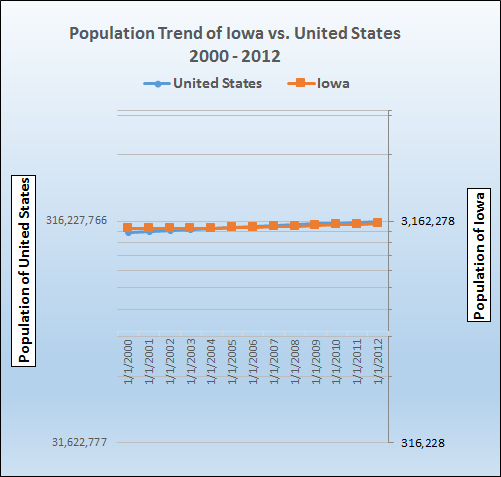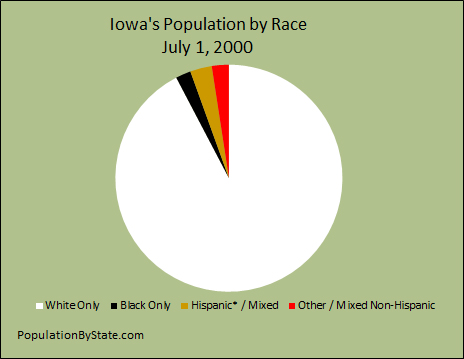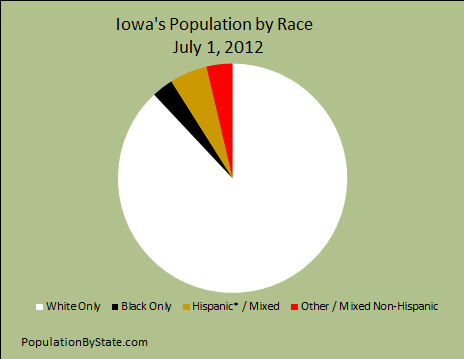
Population of Iowa and the United States Annually from 2000 to 2012 |
|||||||||||||
Territory |
7/1/2012 |
7/1/2011 |
7/1/2010 |
7/1/2009 |
7/1/2008 |
7/1/2007 |
7/1/2006 |
7/1/2005 |
7/1/2004 |
7/1/2003 |
7/1/2002 |
7/1/2001 |
7/1/2000 |
United States |
313,914,040 |
311,591,917 |
309,330,219 |
307,006,550 |
304,374,846 |
301,579,895 |
298,593,212 |
295,753,151 |
293,045,739 |
290,326,418 |
287,803,914 |
285,081,556 |
282,171,957 |
Iowa |
3,074,186 |
3,062,309 |
3,050,202 |
3,007,856 |
2,993,987 |
2,978,719 |
2,964,391 |
2,949,450 |
2,941,358 |
2,932,799 |
2,929,264 |
2,929,424 |
2,928,184 |
Annual Estimates and data of the Resident Population for the United States and States: April 1, 2000 to July 1, 2009 (NST-EST2009-01)
Source: U.S. Census Bureau, Population Division
Release Date: December 2009
Annual Estimates of the Population for the United States and States: April 1, 2010 to July 1, 2011 (NST-EST2011-01)
Source: U.S. Census Bureau, Population Division
Release Date: December 2011

The race percentages for Iowa are shown with the table and charts below that indicate there have been changes from 2000 to 2012. The percentage of the population of white only has decreased from 92.3 to 88.0. The percent of the black only population has increased from 2.2 to 3.0. The percent of population of hispanic / mixed has increased from 3.1% to 5.3% and other/mixed races have increased from 2.4% to 3.7%.
Population by Race for the State of Iowa |
||||
Race |
July 1, 2000 |
% of Total |
July 1, 2012 |
% of Total |
White Only |
2,706,934 |
92.3 |
2,705,594 |
88.0 |
Black Only |
63,498 |
2.2 |
92,767 |
3.0 |
Hispanic* / Mixed |
90,470 |
3.1 |
162,894 |
5.3 |
Other / Mixed Non-Hispanic |
71,095 |
2.4 |
112,931 |
3.7 |
Total Races with Hispanic* |
2,931,997** |
100.00 |
3,074,186 |
100.0 |
*Hispanics are technically not considered a race but rather an ethnicity.
**Note the slight difference of the population used in race chart from population chart above. Totals were taken from U.S. Census bureau which contained differences between it's total population table for the states and population totals for the state with the breakdown of the races.
Representative pie charts for the different races of the Iowa for it's population


References:
Population Estimates, 2013, United States Census Bureau, http://www.census.gov/popest/data/historical/2010s/index.html
List of U.S. states and territories by population, 2013, Wikipedia The Free Encyclopedia, http://en.wikipedia.org/wiki/List_of_U.S._states_and_territories_by_population